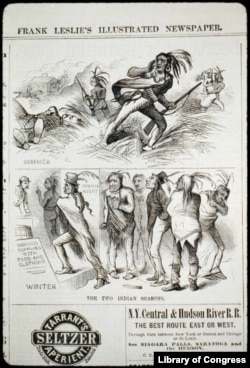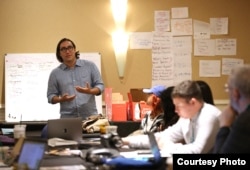A recent report confirms what Native Americans have always known: Most people in the United States know little, if anything, about American Indians. And what they do know is based on questionable information spread by traditional media.
At the same time, the report shows that the U.S. media is ready to help end misunderstandings and build new stories about Native Americans.
The report comes from The First Nations Development Institute and Echo Hawk Consulting, a private advisory business. The two-year “Reclaiming Native Truth” project was designed to study common ideas about Native Americans and find ways to correct stereotypes.
With help from Native American experts, researchers organized nearly 30 study groups across 11 states. The researchers spoke with political, judicial and business leaders. They also questioned more than 13,000 Americans and looked at social media.
Among the findings:
• Native Americans are largely invisible in modern society;
• Non-Native media controls news about Native Americans;
• Stories about Native Americans deal mainly with their problems, not strengths;
• Stereotypes affect law, policy and decision-making;
• Politicians do not understand tribal rights or U.S. treaty requirements.
“Most people said they didn’t know a Native American,” said Sarah Dewees, director of First Nations’ research, policy and asset-building programs. “Many people think that there aren’t many Native Americans left in America, which of course is not true.”
Dewees points out that Americans have conflicting images of Indians, both good and bad, because of history.
The study shows Americans hold competing stereotypes of Native Americans: Both poor and wealthy from legalized gaming; spiritual, but struggling with drug abuse and violence; independent and non-tax-paying, but dependent on federal government assistance.
The report says the belief that Native Americans receive a lot of federal aid is the most harmful because it separates Native Americans from other communities. Many U.S. citizens believe the government gives Native Americans special treatment.
The researchers agree: News media is partly responsible for keeping these stereotypes alive.
“If it bleeds, it leads,’” said Dewees, noting the media’s interest in bad news. “News stories about Native Americans focus on deficits, not positive developments in Indian Country. It’s harder to find an audience for ‘feel-good’ stories, but these are the stories that need to be told.”
The good news, say researchers, is that most Americans see Native Americans’ love of country, high rates of military service, and concerns about family, community and the environment. And they also like tribes’ strength in the face of difficulty, historic oppression and cultural genocide.
The study says most Americans are willing to let go of stereotypes when given facts. That is where the media can make a difference.
Brian Pollard is president of the Native American Journalists Association (NAJA). He said the media has a responsibility to reach out to Native Americans to find the truth.
“One of the things we see very consistently is that many non-Native journalists think that any Indian they talk to will be an expert on that community or that particular issue.”
Pollard also notes the need for reporters to provide context when covering Native issues. He said, “Most people do not understand that each tribe has its unique history, its own culture, and its own story of what has brought that tribe to where it is today.”
The American Society of News Editors has worked for years to increase diversity in news media, but recent information shows minorities remain underrepresented in newsrooms. Native American journalists make less than two-tenths of one percent of people working in traditional media.
As part of the Reclaiming Native Truth project, First Nations has published a guide to help non-Native journalists improve their reports about Indian Country. It is also working with Echo Hawk Consulting to develop a national campaign to increase recognition of and respect for Native Americans.
The “Reclaiming Native Youth” project received money from the W.K. Kellogg Foundation, as well as several other groups and tribes.
I’m Jonathan Evans.
Cecily Hilleary reported this story for VOANews. Susan Shand adapted it for Learning English. The editor was George Grow.
Write to us in the Comments Section or on our Facebook page.
________________________________________________________________
Words in This Story
stereotype – n. an often unfair and untrue belief that many people have about all people or members of a group
invisible – adj. cannot be seen by people
asset – n. a valuable person or thing
of course – phrase. naturally; as expected
focus – v. to direct attention on someone or something
audience – n. a group of people who gather to watch or listen to something
context – n. the words that are used with a certain word or phrase and that help to explain its meaning
unique – adj. different from other things or people
diversity – n. the quality or state of having many different forms or ideas










